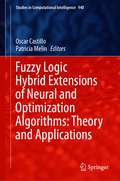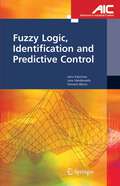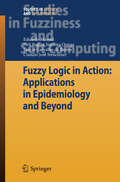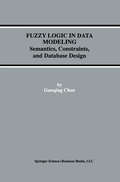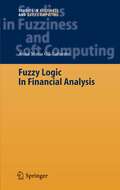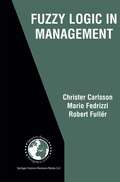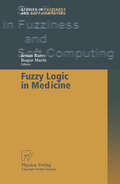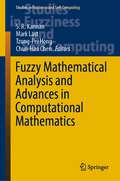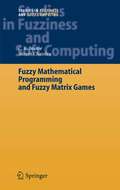- Table View
- List View
Fuzzy Logic Foundations and Industrial Applications (International Series in Intelligent Technologies #8)
by Da RuanFuzzy Logic Foundations and Industrial Applications is an organized edited collection of contributed chapters covering basic fuzzy logic theory, fuzzy linear programming, and applications. Special emphasis has been given to coverage of recent research results, and to industrial applications of fuzzy logic. The chapters are new works that have been written exclusively for this book by many of the leading and prominent researchers (such as Ronald Yager, Ellen Hisdal, Etienne Kerre, and others) in this field. The contributions are original and each chapter is self-contained. The authors have been careful to indicate direct links between fuzzy set theory and its industrial applications. Fuzzy Logic Foundations and Industrial Applications is an invaluable work that provides researchers and industrial engineers with up-to-date coverage of new results on fuzzy logic and relates these results to their industrial use.
Fuzzy Logic Hybrid Extensions of Neural and Optimization Algorithms: Theory and Applications (Studies in Computational Intelligence #940)
by Oscar Castillo Patricia MelinWe describe in this book, recent developments on fuzzy logic, neural networks and optimization algorithms, as well as their hybrid combinations, and their application in areas such as, intelligent control and robotics, pattern recognition, medical diagnosis, time series prediction and optimization of complex problems. The book contains a collection of papers focused on hybrid intelligent systems based on soft computing. There are some papers with the main theme of type-1 and type-2 fuzzy logic, which basically consists of papers that propose new concepts and algorithms based on type-1 and type-2 fuzzy logic and their applications. There also some papers that presents theory and practice of meta-heuristics in different areas of application. Another group of papers describe diverse applications of fuzzy logic, neural networks and hybrid intelligent systems in medical applications. There are also some papers that present theory and practice of neural networks in different areas of application. In addition, there are papers that present theory and practice of optimization and evolutionary algorithms in different areas of application. Finally, there are some papers describing applications of fuzzy logic, neural networks and meta-heuristics in pattern recognition problems.
Fuzzy Logic, Identification and Predictive Control (Advances in Industrial Control)
by Jairo Jose Espinosa Oviedo Joos P.L. Vandewalle Vincent WertzModern industrial processes and systems require adaptable advanced control protocols able to deal with circumstances demanding "judgement” rather than simple "yes/no”, "on/off” responses: circumstances where a linguistic description is often more relevant than a cut-and-dried numerical one. The ability of fuzzy systems to handle numeric and linguistic information within a single framework renders them efficacious for this purpose. Fuzzy Logic, Identification and Predictive Control first shows you how to construct static and dynamic fuzzy models using the numerical data from a variety of real industrial systems and simulations. The second part exploits such models to design control systems employing techniques like data mining. This monograph presents a combination of fuzzy control theory and industrial serviceability that will make a telling contribution to your research whether in the academic or industrial sphere and also serves as a fine roundup of the fuzzy control area for the graduate student.
Fuzzy Logic in Action: Applications in Epidemiology and Beyond (Studies in Fuzziness and Soft Computing #232)
by Eduardo Massad Neli Regina Ortega Laecio Carvalho de Barros Claudio J. StruchinerFuzzy Logic in Action: Applications in Epidemiology and Beyond, co-authored by Eduardo Massad, Neli Ortega, Laécio Barros, and Cláudio Struchiner is a remarkable achievement. The book brings a major paradigm shift to medical sciences exploring the use of fuzzy sets in epidemiology and medical diagnosis arena. The volume addresses the most significant topics in the broad areas of epidemiology, mathematical modeling and uncertainty, embodying them within the framework of fuzzy set and dynamic systems theory. Written by leading contributors to the area of epidemiology, medical informatics and mathematics, the book combines a very lucid and authoritative exposition of the fundamentals of fuzzy sets with an insightful use of the fundamentals in the area of epidemiology and diagnosis. The content is clearly illustrated by numerous illustrative examples and several real world applications. Based on their profound knowledge of epidemiology and mathematical modeling, and on their keen understanding of the role played by uncertainty and fuzzy sets, the authors provide insights into the connections between biological phenomena and dynamic systems as a mean to predict, diagnose, and prescribe actions. An example is the use of Bellman-Zadeh fuzzy decision making approach to develop a vaccination strategy to manage measles epidemics in São Paulo. The book offers a comprehensive, systematic, fully updated and self- contained treatise of fuzzy sets in epidemiology and diagnosis. Its content covers material of vital interest to students, researchers and practitioners and is suitable both as a textbook and as a reference. The authors present new results of their own in most of the chapters. In doing so, they reflect the trend to view fuzzy sets, probability theory and statistics as an association of complementary and synergetic modeling methodologies.
Fuzzy Logic in Data Modeling: Semantics, Constraints, and Database Design (Advances in Database Systems #15)
by Guoqing Chenalso in: THE KLUWER INTERNATIONAL SERIES ON ASIAN STUDIES IN COMPUTER AND INFORMATION SCIENCE, Volume 2
Fuzzy Logic in Financial Analysis (Studies in Fuzziness and Soft Computing #175)
by Anna Maria Gil-LafuenteIn today’s increasingly complex and uncertain business environment, financial analysis is yet more critical to business managers who tackle problems of an economic or business nature. Knowledge based on formal logic and even experience becomes less sufficient. This volume systematically sets out the basic elements on which to base financial analysis for business in the new century. It incorporates a previous work that can serve as the basis and foundation for the new contributions that are now being made in the field of financial economy and intend to provide business with instruments and models suitable for dealing with the new economic context. In dealing with rapid and unpredictable changes in technological and business conditions, it postulates a growing reliance on the opinions of experts instead of past data or probabilistic forecasts, which is a radical change but may yield fruitful results. For this reason, much emphasis is devoted to the problem of aggregation of the opinion of experts in the financial field, with the object of limiting, wherever possible, the subjective component of the opinions and making sure that the decisions have the best guarantee of reaching the desired objectives.
Fuzzy Logic in Intelligent System Design: Theory and Applications (Advances in Intelligent Systems and Computing #648)
by Patricia Melin Oscar Castillo Janusz Kacprzyk Marek Reformat William MelekThis book describes recent advances in the use of fuzzy logic for the design of hybrid intelligent systems based on nature-inspired optimization and their applications in areas such as intelligent control and robotics, pattern recognition, medical diagnosis, time series prediction and optimization of complex problems. Based on papers presented at the North American Fuzzy Information Processing Society Annual Conference (NAFIPS 2017), held in Cancun, Mexico from 16 to 18 October 2017, the book is divided into nine main parts, the first of which first addresses theoretical aspects, and proposes new concepts and algorithms based on type-1 fuzzy systems. The second part consists of papers on new concepts and algorithms for type-2 fuzzy systems, and on applications of type-2 fuzzy systems in diverse areas, such as time series prediction and pattern recognition. In turn, the third part contains papers that present enhancements to meta-heuristics based on fuzzy logic techniques describing new nature-inspired optimization algorithms that use fuzzy dynamic adaptation of parameters. The fourth part presents emergent intelligent models, which range from quantum algorithms to cellular automata. The fifth part explores applications of fuzzy logic in diverse areas of medicine, such as the diagnosis of hypertension and heart diseases. The sixth part describes new computational intelligence algorithms and their applications in different areas of intelligent control, while the seventh examines the use of fuzzy logic in different mathematic models. The eight part deals with a diverse range of applications of fuzzy logic, ranging from environmental to autonomous navigation, while the ninth covers theoretical concepts of fuzzy models
Fuzzy Logic in Its 50th Year: New Developments, Directions and Challenges (Studies in Fuzziness and Soft Computing #341)
by Cengiz Kahraman Uzay Kaymak Adnan YaziciThis book offers a multifaceted perspective on fuzzy set theory, discussing its developments over the last 50 years. It reports on all types of fuzzy sets, from ordinary to hesitant fuzzy sets, with each one explained by its own developers, authoritative scientists well known for their previous works. Highlighting recent theorems and proofs, the book also explores how fuzzy set theory has come to be extensively used in almost all branches of science, including the health sciences, decision science, earth science and the social sciences alike. It presents a wealth of real-world sample applications, from routing problem to robotics, and from agriculture to engineering. By offering a comprehensive, timely and detailed portrait of the field, the book represents an excellent reference guide for researchers, lecturers and postgraduate students pursuing research on new fuzzy set extensions.
Fuzzy Logic in Management (International Series in Operations Research & Management Science #66)
by Christer Carlsson Mario Fedrizzi Robert FullerThis book shows how the application of fuzzy logic can benefit management, group decision making, strategic planning, supply chain management and other business imperatives. The theoretical analysis is fully supported by real-life case studies. The book develops themes that businesses can use to master effectiveness and quality, work with flexibility, and support continuous learning in the organization and the individual.
Fuzzy Logic in Medicine (Studies in Fuzziness and Soft Computing #83)
by Senen Barro Roque MarinTo say that Fuzzy Logic in Medicine, or FLM for short, is an important addi tion to the literature of fuzzy logic and its applications, is an understatement. Edited by two prominent informaticians, Professors S. Barro and R. Marin, it is one of the first books in its field. Between its covers, FLM presents authoritative expositions of a wide spectrum of medical and biological ap plications of fuzzy logic, ranging from image classification and diagnostics to anaesthesia control and risk assessment of heart diseases. As the editors note in the preface, recognition of the relevance of fuzzy set theory and fuzzy logic to biological and medical systems has a long history. In this context, particularly worthy of note is the pioneering work of Profes sor Klaus Peter Adlassnig of the University of Vienna School of Medicine. However, it is only within the past decade that we began to see an accelerat ing growth in the visibility and importance of publications falling under the rubric of fuzzy logic in medicine and biology -a leading example of which is the Journal of the Biomedical Fuzzy Systems Association in Japan. Why did it take so long for this to happen? First, a bit of history.
Fuzzy Logic of Quasi-Truth: An Algebraic Treatment (Studies in Fuzziness and Soft Computing #338)
by Antonio Di Nola Revaz Grigolia Esko TurunenThis book presents the first algebraic treatment of quasi-truth fuzzy logic and covers the algebraic foundations of many-valued logic. It offers a comprehensive account of basic techniques and reports on important results showing the pivotal role played by perfect many-valued algebras (MV-algebras). It is well known that the first-order predicate Łukasiewicz logic is not complete with respect to the canonical set of truth values. However, it is complete with respect to all linearly ordered MV –algebras. As there are no simple linearly ordered MV-algebras in this case, infinitesimal elements of an MV-algebra are allowed to be truth values. The book presents perfect algebras as an interesting subclass of local MV-algebras and provides readers with the necessary knowledge and tools for formalizing the fuzzy concept of quasi true and quasi false. All basic concepts are introduced in detail to promote a better understanding of the more complex ones. It is an advanced and inspiring reference-guide for graduate students and researchers in the field of non-classical many-valued logics.
Fuzzy Logic Techniques for Autonomous Vehicle Navigation (Studies in Fuzziness and Soft Computing #61)
by Dimiter DriankovIn the past decade a critical mass of work that uses fuzzy logic for autonomous vehicle navigation has been reported. Unfortunately, reports of this work are scattered among conference, workshop, and journal publications that belong to different research communities (fuzzy logic, robotics, artificial intelligence, intelligent control) and it is therefore not easily accessible either to the new comer or to the specialist. As a result, researchers in this area may end up reinventing things while being unaware of important existing work. We believe that research and applications based on fuzzy logic in the field of autonomous vehicle navigation have now reached a sufficient level of maturity, and that it should be suitably reported to the largest possible group of interested practitioners, researches, and students. On these grounds, we have endeavored to collect some of the most representative pieces of work in one volume to be used as a reference. Our aim was to provide a volume which is more than "yet another random collection of papers," and gives the reader some added value with respect to the individual papers. In order to achieve this goal we have aimed at: • Selecting contributions which are representative of a wide range of prob lems and solutions and which have been validated on real robots; and • Setting the individual contributions in a clear framework, that identifies the main problems of autonomous robotics for which solutions based on fuzzy logic have been proposed.
Fuzzy Logic Type 1 and Type 2 Based on LabVIEW™ FPGA (Studies in Fuzziness and Soft Computing #334)
by Pedro Ponce-Cruz Arturo Molina Brian MacCleeryThis book is a comprehensive introduction to LabVIEW FPGA™, a package allowing the programming of intelligent digital controllers in field programmable gate arrays (FPGAs) using graphical code. It shows how both potential difficulties with understanding and programming in VHDL and the consequent difficulty and slowness of implementation can be sidestepped. The text includes a clear theoretical explanation of fuzzy logic (type 1 and type 2) with case studies that implement the theory and systematically demonstrate the implementation process. It goes on to describe basic and advanced levels of programming LabVIEW FPGA and show how implementation of fuzzy-logic control in FPGAs improves system responses. A complete toolkit for implementing fuzzy controllers in LabVIEW FPGA has been developed with the book so that readers can generate new fuzzy controllers and deploy them immediately. Problems and their solutions allow readers to practice the techniques and to absorb the theoretical ideas as they arise. Fuzzy Logic Type 1 and Type 2 Based on LabVIEW FPGA™, helps students studying embedded control systems to design and program those controllers more efficiently and to understand the benefits of using fuzzy logic in doing so. Researchers working with FPGAs find the text useful as an introduction to LabVIEW and as a tool helping them design embedded systems.
Fuzzy Logik: Theorie und Praxis 4. Dortmunder Fuzzy-Tage Dortmund, 6.–8. Juni 1994 (Informatik aktuell)
by Bernd ReuschFuzzy Machine Learning Algorithms for Remote Sensing Image Classification
by Anil Kumar Priyadarshi Upadhyay A. Senthil KumarThis book covers the state-of-art image classification methods for discrimination of earth objects from remote sensing satellite data with an emphasis on fuzzy machine learning and deep learning algorithms. Both types of algorithms are described in such details that these can be implemented directly for thematic mapping of multiple-class or specific-class landcover from multispectral optical remote sensing data. These algorithms along with multi-date, multi-sensor remote sensing are capable to monitor specific stage (for e.g., phenology of growing crop) of a particular class also included. With these capabilities fuzzy machine learning algorithms have strong applications in areas like crop insurance, forest fire mapping, stubble burning, post disaster damage mapping etc. It also provides details about the temporal indices database using proposed Class Based Sensor Independent (CBSI) approach supported by practical examples. As well, this book addresses other related algorithms based on distance, kernel based as well as spatial information through Markov Random Field (MRF)/Local convolution methods to handle mixed pixels, non-linearity and noisy pixels. Further, this book covers about techniques for quantiative assessment of soft classified fraction outputs from soft classification and supported by in-house developed tool called sub-pixel multi-spectral image classifier (SMIC). It is aimed at graduate, postgraduate, research scholars and working professionals of different branches such as Geoinformation sciences, Geography, Electrical, Electronics and Computer Sciences etc., working in the fields of earth observation and satellite image processing. Learning algorithms discussed in this book may also be useful in other related fields, for example, in medical imaging. Overall, this book aims to: exclusive focus on using large range of fuzzy classification algorithms for remote sensing images; discuss ANN, CNN, RNN, and hybrid learning classifiers application on remote sensing images; describe sub-pixel multi-spectral image classifier tool (SMIC) to support discussed fuzzy and learning algorithms; explain how to assess soft classified outputs as fraction images using fuzzy error matrix (FERM) and its advance versions with FERM tool, Entropy, Correlation Coefficient, Root Mean Square Error and Receiver Operating Characteristic (ROC) methods and; combines explanation of the algorithms with case studies and practical applications.
Fuzzy Machine Learning Algorithms for Remote Sensing Image Classification
by Anil Kumar Priyadarshi Upadhyay A. Senthil KumarThis book covers the state-of-art image classification methods for discrimination of earth objects from remote sensing satellite data with an emphasis on fuzzy machine learning and deep learning algorithms. Both types of algorithms are described in such details that these can be implemented directly for thematic mapping of multiple-class or specific-class landcover from multispectral optical remote sensing data. These algorithms along with multi-date, multi-sensor remote sensing are capable to monitor specific stage (for e.g., phenology of growing crop) of a particular class also included. With these capabilities fuzzy machine learning algorithms have strong applications in areas like crop insurance, forest fire mapping, stubble burning, post disaster damage mapping etc. It also provides details about the temporal indices database using proposed Class Based Sensor Independent (CBSI) approach supported by practical examples. As well, this book addresses other related algorithms based on distance, kernel based as well as spatial information through Markov Random Field (MRF)/Local convolution methods to handle mixed pixels, non-linearity and noisy pixels. Further, this book covers about techniques for quantiative assessment of soft classified fraction outputs from soft classification and supported by in-house developed tool called sub-pixel multi-spectral image classifier (SMIC). It is aimed at graduate, postgraduate, research scholars and working professionals of different branches such as Geoinformation sciences, Geography, Electrical, Electronics and Computer Sciences etc., working in the fields of earth observation and satellite image processing. Learning algorithms discussed in this book may also be useful in other related fields, for example, in medical imaging. Overall, this book aims to: exclusive focus on using large range of fuzzy classification algorithms for remote sensing images; discuss ANN, CNN, RNN, and hybrid learning classifiers application on remote sensing images; describe sub-pixel multi-spectral image classifier tool (SMIC) to support discussed fuzzy and learning algorithms; explain how to assess soft classified outputs as fraction images using fuzzy error matrix (FERM) and its advance versions with FERM tool, Entropy, Correlation Coefficient, Root Mean Square Error and Receiver Operating Characteristic (ROC) methods and; combines explanation of the algorithms with case studies and practical applications.
Fuzzy Management: Trilogie Teil II: Einsatz der unscharfen Logik für Business Intelligence (essentials)
by Andreas Meier Edy PortmannAndreas Meier und Edy Portmann verwenden in diesem essential über Fuzzy Management die unscharfe Logik zur Lösung betriebswirtschaftlicher Probleme in der digitalen Wirtschaft. Die unscharfe Logik erweitert die klassische Logik mit den beiden Werten „wahr“ und „falsch“ und führt zu differenzierteren Beurteilungen. Neben Portfolio Management, Performance Measurement, Service Level Engineering und Reputationsmanagement wird die Business Intelligence mit weichen Faktoren angereichert, um den Entscheidungsprozess zu verbessern.Die Autoren: Prof. Dr. Andreas Meier leitete in den Jahren 1999 bis 2018 den Lehrstuhl für Wirtschaftsinformatik an der Universität Fribourg, Schweiz. Seine Forschungsgebiete waren eBusiness, eGovernment und Informationsmanagement. Prof. Dr. Edy Portmann ist Swiss Post Professor of Computer Science am Human-IST Institut der Universität Fribourg, Schweiz. In seiner Forschung beschäftigt er sich mit Fragen rund um Informationssysteme, -verarbeitung und -beschaffung.
Fuzzy Mathematical Analysis and Advances in Computational Mathematics (Studies in Fuzziness and Soft Computing #419)
by S. R. Kannan Mark Last Tzung-Pei Hong Chun-Hao ChenThe edited volume includes papers in the fields of fuzzy mathematical analysis and advances in computational mathematics. The fields of fuzzy mathematical analysis and advances in computational mathematics can provide valuable solutions to complex problems. They have been applied in multiple areas such as high dimensional data analysis, medical diagnosis, computer vision, hand-written character recognition, pattern recognition, machine intelligence, weather forecasting, network optimization, VLSI design, etc. The volume covers ongoing research in fuzzy and computational mathematical analysis and brings forward its recent applications to important real-world problems in various fields. The book includes selected high-quality papers from the International Conference on Fuzzy Mathematical Analysis and Advances in Computational Mathematics (FMAACM 2020).
Fuzzy Mathematical Programming and Fuzzy Matrix Games (Studies in Fuzziness and Soft Computing #169)
by C. R. Bector Suresh ChandraGame theory has already proved its tremendous potential for con?ict resolution problems in the ?elds of Decision Theory and Economics. In the recent past, there have been attempts to extend the results of crisp game theory to those con?ict resolution problems which are fuzzy in nature e.g. Nishizaki and Sakawa [61] and references cited there in. These developments have lead to the emergence of a new area in the literature called fuzzy games. Another area in the fuzzy decision theory, which has been growing very fast is the area of fuzzy mathematical programming and its applications to various branches of sciences, Engineering and Management. In the crisp scenario, there exists a beautiful relationship between two person zero sum matrix game theory and duality in linear p- gramming. It is therefore natural to ask if something similar holds in the fuzzy scenario as well. This discussion essentially constitutes the core of our presentation. The objective of this book is to present a systematic and focussed study of the application of fuzzy sets to two very basic areas of decision theory, namely Mathematical Programming and Matrix Game Theory.
Fuzzy Mathematics: An Introduction for Engineers and Scientists (Studies in Fuzziness and Soft Computing #20)
by John N. Mordeson Premchand S. NairIn the mid-1960's I had the pleasure of attending a talk by Lotfi Zadeh at which he presented some of his basic (and at the time, recent) work on fuzzy sets. Lotfi's algebra of fuzzy subsets of a set struck me as very nice; in fact, as a graduate student in the mid-1950's, I had suggested similar ideas about continuous-truth-valued propositional calculus (inffor "and", sup for "or") to my advisor, but he didn't go for it (and in fact, confused it with the foundations of probability theory), so I ended up writing a thesis in a more conventional area of mathematics (differential algebra). I especially enjoyed Lotfi's discussion of fuzzy convexity; I remember talking to him about possible ways of extending this work, but I didn't pursue this at the time. I have elsewhere told the story of how, when I saw C. L. Chang's 1968 paper on fuzzy topological spaces, I was impelled to try my hand at fuzzi fying algebra. This led to my 1971 paper "Fuzzy groups", which became the starting point of an entire literature on fuzzy algebraic structures. In 1974 King-Sun Fu invited me to speak at a U. S. -Japan seminar on Fuzzy Sets and their Applications, which was to be held that summer in Berkeley.
Fuzzy Mathematics: Approximation Theory (Studies in Fuzziness and Soft Computing #251)
by George A. AnastassiouThis monograph is the r st in Fuzzy Approximation Theory. It contains mostly the author s research work on fuzziness of the last ten years and relies a lot on [10]-[32] and it is a natural outgrowth of them. It belongs to the broader area of Fuzzy Mathematics. Chapters are self-contained and several advanced courses can be taught out of this book. We provide lots of applications but always within the framework of Fuzzy Mathematics. In each chapter is given background and motivations. A c- plete list of references is provided at the end. The topics covered are very diverse. In Chapter 1 we give an extensive basic background on Fuzziness and Fuzzy Real Analysis, as well a complete description of the book. In the following Chapters 2,3 we cover in deep Fuzzy Di?erentiation and Integ- tion Theory, e.g. we present Fuzzy Taylor Formulae. It follows Chapter 4 on Fuzzy Ostrowski Inequalities. Then in Chapters 5, 6 we present results on classical algebraic and trigonometric polynomial Fuzzy Approximation.
Fuzzy Mathematics in Economics and Engineering (Studies in Fuzziness and Soft Computing #91)
by James J. Buckley Esfandiar Eslami Thomas FeuringThe book aims at surveying results in the application of fuzzy sets and fuzzy logic to economics and engineering. New results include fuzzy non-linear regression, fully fuzzified linear programming, fuzzy multi-period control, fuzzy network analysis, each using an evolutionary algorithm; fuzzy queuing decision analysis using possibility theory; fuzzy differential equations; fuzzy difference equations; fuzzy partial differential equations; fuzzy eigenvalues based on an evolutionary algorithm; fuzzy hierarchical analysis using an evolutionary algorithm; fuzzy integral equations. Other important topics covered are fuzzy input-output analysis; fuzzy mathematics of finance; fuzzy PERT (project evaluation and review technique). No previous knowledge of fuzzy sets is needed. The mathematical background is assumed to be elementary calculus.
Fuzzy Model Identification: Selected Approaches
by Hans Hellendoorn Dimiter DriankovDuring the past few years two principally different approaches to the design of fuzzy controllers have emerged: heuristics-based design and model-based design. The main motivation for the heuristics-based design is given by the fact that many industrial processes are still controlled in one of the following two ways: - The process is controlled manually by an experienced operator. - The process is controlled by an automatic control system which needs manual, on-line 'trimming' of its parameters by an experienced operator. In both cases it is enough to translate in terms of a set of fuzzy if-then rules the operator's manual control algorithm or manual on-line 'trimming' strategy in order to obtain an equally good, or even better, wholly automatic fuzzy control system. This implies that the design of a fuzzy controller can only be done after a manual control algorithm or trimming strategy exists. It is admitted in the literature on fuzzy control that the heuristics-based approach to the design of fuzzy controllers is very difficult to apply to multiple-inputjmultiple-output control problems which represent the largest part of challenging industrial process control applications. Furthermore, the heuristics-based design lacks systematic and formally verifiable tuning tech niques. Also, studies of the stability, performance, and robustness of a closed loop system incorporating a heuristics-based fuzzy controller can only be done via extensive simulations.
Fuzzy Modeling and Control: Theory And Applications (Atlantis Computational Intelligence Systems #9)
by Fernando Matía G. Nicolás Marichal Emilio JiménezMuch work on fuzzy control, covering research, development and applications, has been developed in Europe since the 90's. Nevertheless, the existing books in the field are compilations of articles without interconnection or logical structure or they express the personal point of view of the author. This book compiles the developments of researchers with demonstrated experience in the field of fuzzy control following a logic structure and a unified the style. The first chapters of the book are dedicated to the introduction of the main fuzzy logic techniques, where the following chapters focus on concrete applications. This book is supported by the EUSFLAT and CEA-IFAC societies, which include a large number of researchers in the field of fuzzy logic and control. The central topic of the book, Fuzzy Control, is one of the main research and development lines covered by these associations.

